Stay warm and safe with these fireplace and chimney tips
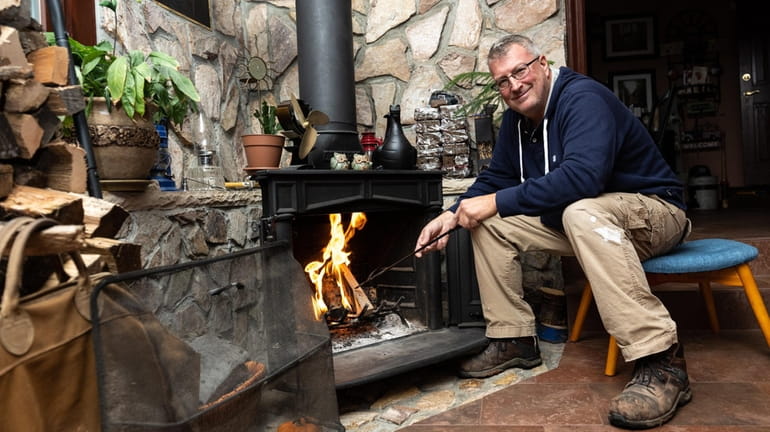
Pat Sais at home in Hicksville. Credit: Dawn McCormick
When Jongmin Kim moved from Flushing, Queens, to Woodbury three years ago, he couldn’t wait to use his brick fireplace. “A fireplace was something I always wanted to have,” said Kim, 51, a pharmacist. “I thought it’d be nice on a chilly, fall or winter day to light up a fire and sit with your family.”
Kim’s first fire instead turned into a crash course in what not to do, after he fed it wet wood he’d gathered from his yard. “Pinewood has a lot of sap,” Kim said, “so it will produce a lot of smoke and soot, and it burns very quickly.”
These days, Kim, who has since become a volunteer firefighter in Woodbury, takes many measures to make things go smoothly: He buys rather than gathers wood, wears fire-resistant gloves, and sweeps ashes into an ash bucket.
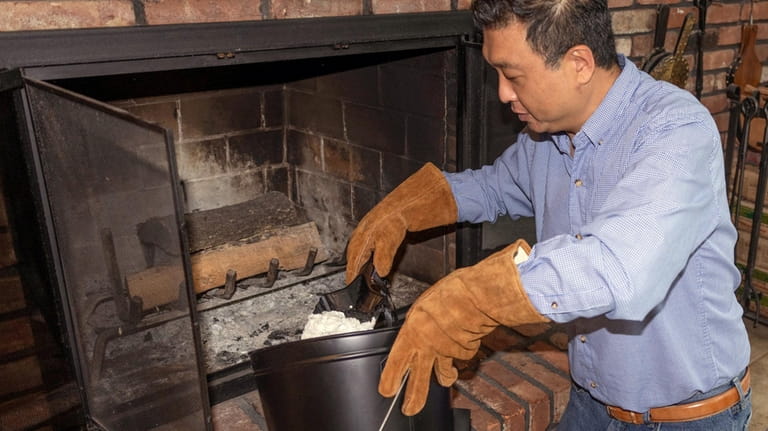
Jongmin Kim, a volunteer firefighter, has safety top of mind as he tends to the fireplace at his Woodbury home. Credit: Debbie Egan-Chin
Winter is coming, and Long Islanders are looking forward to cozy times gathered in front of the fire.
“That’s my enjoyment,” said Stephanie Vetter, 75, a homemaker in Huntington. “Netflix, a nice fire and a little glass of vino, and I’m good to go.”
But it’s not just a matter of throwing some logs on and putting your feet up. Safety is crucial. These homeowners and pros shared tips for staying safe and snug while using a fireplace.
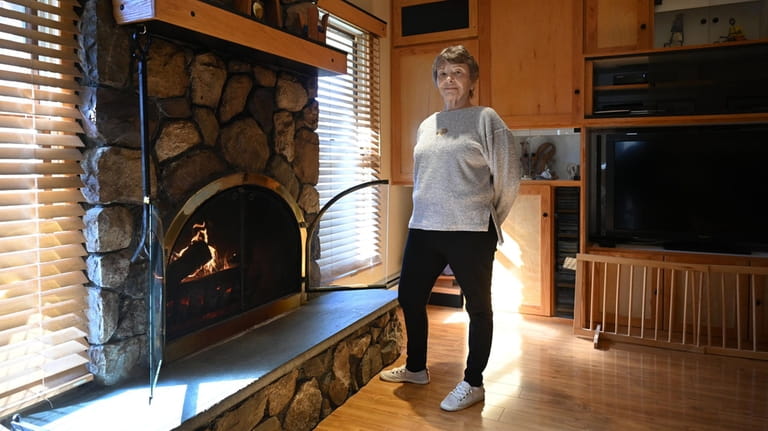
Stephanie Vetter's fireplace is a key feature of her Huntington home. “Netflix, a nice fire and a little glass of vino, and I’m good to go," she said. Credit: Danielle Silverman
Safety first
There are more than 17,000 chimney-related fires nationwide annually, according to the Chimney Safety Institute of America. Creosote, a flammable residue formed by wood-burning fires, is a primary source.
“After it builds up, it can cause chimney fires if you don’t sweep the chimney and clean it out,” said Pat Sais, president of Smokey Chimney and Maintenance, based in Massapequa.
Preventing and removing creosote is a key part of fireplace and chimney safety. Constricted air supply, unseasoned wood and lack of cleaning can lead to creosote, sparking fires up to 2,000 degrees Fahrenheit, enough to melt metal flue liners, according to the CSIA.
Maintenance matters
This is flue season for many: Flues, chimneys and fireplaces should be inspected annually followed by cleaning as needed, according to the National Fire Protection Association.
“You want to make sure there’s no cracking in the bricks,” Kim said.
Signs indicating a need for cleaning include black, oily spots in fireplaces, difficulty starting and maintaining fires, stronger odor than usual from fireplaces and, naturally, animals in the chimney.
Sais recommends inspecting and cleaning, which typically costs $100 and up, after 50 to 60 fires, burning a cord of wood or whichever comes first.
“Everybody uses their fireplaces differently,” he said. “Some people burn it a couple of times a year. If you have a wood-burning stove, you could burn it daily. The more you burn, the more you have to clean.”
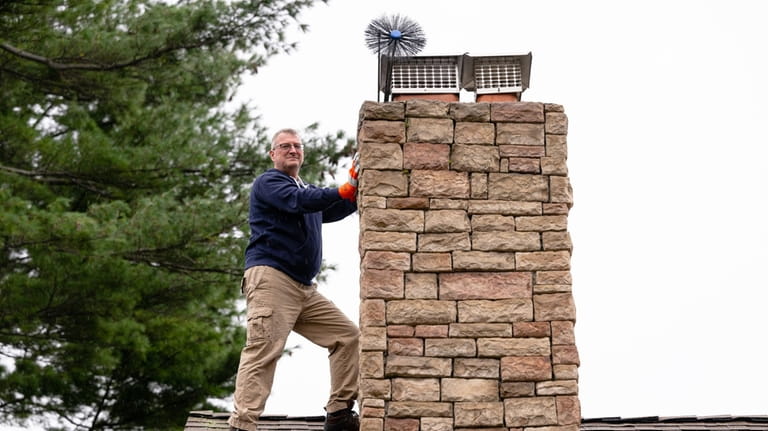
Pat Sais on the roof of his home in Hicksville. He recommends inspecting and cleaning a chimney after 50 to 60 fires, burning a cord of wood or whichever comes first. Credit: Dawn McCormick
Chimney caps
Flues, or chimney liners, should be checked for cracks and tile deterioration where water can get in. In most cases where flue repair is needed, it’s only the top section, which costs $500 to replace, including the crown, Sais said.
Raincaps, ideally made of stainless steel and bolted to chimneys to keep out animals and water, and sparks from escaping, cost $100 or more to replace, including installation.
Stoves
Bill Martakis, 62, a service manager at a Chevrolet dealership, who lives in Glen Head, said he has his wood stove, chimney and flue cleaned every three months in the winter, because he uses it daily. “That’s the only means of heat in my cigar room,” he said. “I like it nice and toasty when I’m having my cigar.”
It’s important to clean out soot to avoid a chimney fire. Sais said good stove cleanings involve disassembling stoves to clean the parts, because many are used more often than fireplaces.
Enza Brandi, an attorney in her 50s, said she uses the wood stove in her Northport home often because the open floor plan lets the warmth circulate. “It heats the entire house,” Brandi said. “It’s fantastic.”
A wood stove is much more efficient than a traditional fireplace, which can emit up to eight times as much global warming carbon dioxide per unit, according to The Sierra Club.

Enza Brandi's wood-burning stove can heat her entire Northport home. Credit: Rick Kopstein
Backdrafts
A fire using wood that isn’t properly dried can lead to a backdraft, which sends smoke rolling down the chimney into your living space.
Sais recommends preheating chimneys by lighting paper and sticking it in the smoke chamber. “The flame will create a draft,” he said. “If you don’t preheat, your smoke will roll back.”
Caps help prevent wind from blowing down chimneys. “The taller the chimney, the better the draft,” Sais said, noting that chimneys typically are 20 feet tall and up. “If it is short, sometimes you’ll get wind blowing down it.”
Embers
Embers can be dangerous if they come out of the fireplace. Noncombustible materials such as tile, stone or brick should be used to surround a fireplace.
“Once the fire’s dying out, you break it up with fireplace tools and close the screen and doors,” Sais said. “That will starve it for oxygen.”
While most fireplaces have screens or something to block embers, airtight panels are best, Sais said, adding, “I wouldn’t leave it burning with only a screen.”
Brandi’s wood-burning stove insert has a heavy glass and iron door. “Once I get the fire going, I shut the door and it continues burning on its own,” she said.
Managing embers is important. Kim doesn’t throw water on an indoor fire, because “it will smoke up a lot more.” Vetter brushes ashes through a hatch into a metal holder, and Martakis keeps embers in a metal can for a few days until they cool completely, before dumping them.
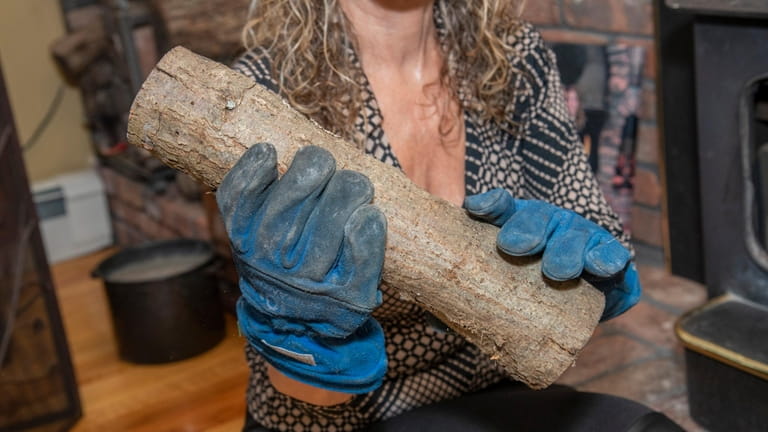
Enza Brandi wears heat-resistant gloves to load wood in the fireplace. Credit: Rick Kopstein
Tools
Residences generally have a firewood poker, but other tools can come in handy. Brandi uses insulated gloves to load wood in the fireplace, while Kim uses welding gloves with long sleeves that cost about $25. Brandi has a fire-retardant rug in front of her fireplace near a screen to prevent embers from escaping. Fire-resistant fireplace rugs generally cost $30 and up, with large, ornate rugs reaching $200.
Kim uses a black ash bucket with a lid to sweep away ash, but warns against galvanized metal trash cans, which can release gases into the atmosphere that “you don’t want to breathe.” He favors materials such as carbon steel similar to those used for frying pans that don’t emit odors or chemicals.
Kim keeps two fire extinguishers (about $20 each) 5 and 10 feet from the fireplace, and an infrared thermometer, also roughly $20, to check hot surfaces to make sure they’re not too hot to touch. “I aim it at whatever I feel may be hot in the fireplace and the surrounding area,” he said of the thermometer he sometimes uses.

Charles Bongiorno Jr. at his East Northport firewood yard. Credit: Via Charles Bongiorno Jr.
Wood works
Good fires begin with good wood, available at stores, gas stations and elsewhere, but Stephanie Vetter likes getting all the wood she needs at once. She has a cord of wood (4 feet high by 4 feet wide and 8 feet long stacked) delivered to her house.
“I make sure it’s seasoned hardwood,” she said. “Soft wood creates creosote in your chimney, which isn’t a good thing.” She buys her wood from Bongiorno's Long Island Firewood in East Northport, which stocks oak, cherry and maple.
Getting the right amount of wood is a good start, said owner Charles F. Bongiorno Jr. “It’s like, ‘How long will a tank of gas last on your car?’ ” he said. “Some people can buy one cord for the whole year. Some make a half cord last the whole year.”
Wood collected from the backyard might be convenient, but typically won’t burn well and may have fungus, which adds moisture that can create popping noises and make it harder to start a fire.
While many residents may enjoy the pop of wood burning, Kim said that’s often caused by moisture. “The popping may sound cool, but it can be dangerous,” he said. “When it pops, you can have embers flying all over the place.”
Bongiorno said fires that hiss can also be dangerous and can damage the chimney. “It’s bad for the chimney because of creosote,” he said. “A spark goes in and ignites the flue.”
Storage
People sometimes throw wood into piles on their property to age and dry. “It’s not aged properly, because it doesn’t get insulated,” said Bongiorno, who recommends wood dried by sunlight in ventilated bags covered by tarps.
Sais suggests storing wood off bare ground to avoid bugs and rodents making themselves at home, kept beneath a cover to ensure it stays dry.
Many people store wood on racks behind their house or in the garage. Martakis stores his on a firewood rack on his driveway, while Vetter keeps hers at the top of her driveway, throwing a tarp on top to protect from rain and snow.
— Claude Solnik
